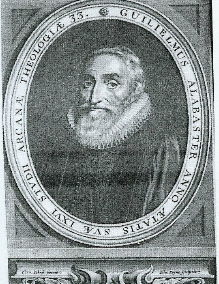William Alabaster facts for kids
William Alabaster (1567–1640) was an English writer and poet. He wrote in Neo-Latin, which was Latin used in new ways during the Renaissance. He also wrote plays and religious books.
William Alabaster became a Roman Catholic while working as a chaplain (a religious leader) in Spain. Because of his beliefs, he was put in prison several times. Later, he returned to the Church of England and was liked by King James I. He received a special position at St Paul's Cathedral, London and worked as a priest in Therfield, Hertfordshire. He passed away in Little Shelford, Cambridgeshire.
William Alabaster's Life Story
William Alabaster was born in Hadleigh, Suffolk. His father, Roger Alabaster, came from a family of cloth merchants who followed the Puritan faith. His mother, Bridget Winthrop, was related to John Winthrop, who later became the Governor of the Massachusetts Bay Colony in America.
William went to Westminster School and then to Trinity College, Cambridge starting in 1583. He became a fellow (a senior member) at Trinity.
In 1596, Alabaster joined an expedition to Cadiz in Spain as an Anglican military chaplain. While on a diplomatic trip that followed, he changed his faith from Anglicanism to Roman Catholicism.
After returning from Spain, Alabaster was given a church position as Vicar of Landulph in Cornwall. However, he soon decided to become a Catholic. He met with a Jesuit priest named Thomas Wright, who convinced him of the Catholic faith. On July 13, 1597, Alabaster secretly became a Catholic. This meant he had to give up his church position and his plans to get married.
Alabaster wrote a pamphlet called Seven Motives to explain why he changed his faith, but no copies of it exist today. Around 1597, he wrote a Latin play called Roxana. Some people believed this play was against the Church of England.
Because he became a Catholic, Alabaster was put in prison in the Tower of London and The Clink in 1597 and 1598. While in prison, he wrote many religious poems called sonnets. These poems showed his deep spiritual experiences.
After escaping from The Clink, a Catholic priest named John Gerard hid Alabaster in a secret Catholic safe house in London. During this time, Alabaster studied the teachings of St. Ignatius Loyola and wanted to join the Jesuit Order. Father Gerard helped him travel to the Spanish Netherlands (part of modern-day Belgium and Netherlands).
In 1607, Alabaster published a book in Belgium called Apparatus in Revelationem Jesu Christi. In this book, he used his study of Kabbalah (a mystical way of understanding religious texts) to explain the Christian Bible. This book was later banned by the Vatican. He went to Rome and was imprisoned for a short time by the Roman Inquisition.
However, Alabaster managed to return to England and rejoined the Established Church (the Church of England). He became a doctor of divinity at Cambridge University and a chaplain to King James I. After marrying in 1618, his life became more stable, and he spent his later years studying theology. He had a large library of books.
Personal Life
In 1618, William Alabaster married Katherine Fludd, who was a widow. Through this marriage, he became related to the famous doctor and alchemist Robert Fludd.
Death
William Alabaster died in 1640. At the time of his death, he was serving as the Vicar of St. Dunstan's-in-the-West and passed away in Little Shelford, Cambridgeshire.
William Alabaster's Writings
Alabaster's play Roxana was inspired by older Roman plays. Some people, like Samuel Johnson, thought it was one of the best Latin poems written in England before Milton. However, others believed it copied parts from another play called La Dalida.
He also wrote a long Latin poem called Elisaeis, which honored Queen Elizabeth I. The poet Edmund Spenser greatly admired this poem.
Later in his life, Alabaster wrote other religious books, including Commentarius de Bestia Apocalyptica (1621) and Spiraculum tubarum (1633). These books were mystical interpretations of parts of the Christian Bible. The poet Robert Herrick praised these writings.
Here is a list of some of his works:
- Roxana – (around 1595) A Latin play.
- Elisaeis – A Latin epic poem about Elizabeth I.
- Apparatus in Revelationem Jesu Christi (1607).
- De bestia Apocalypsis (1621).
- Ecce sponsus venit (1633).
- Spiraculum Tubarum (1633).
- Lexicon Pentaglotton, Hebraicum, Chaldaicum, Syriacum, Talmudico-Rabbinicon et Arabicum (1637) – A dictionary of five languages.




